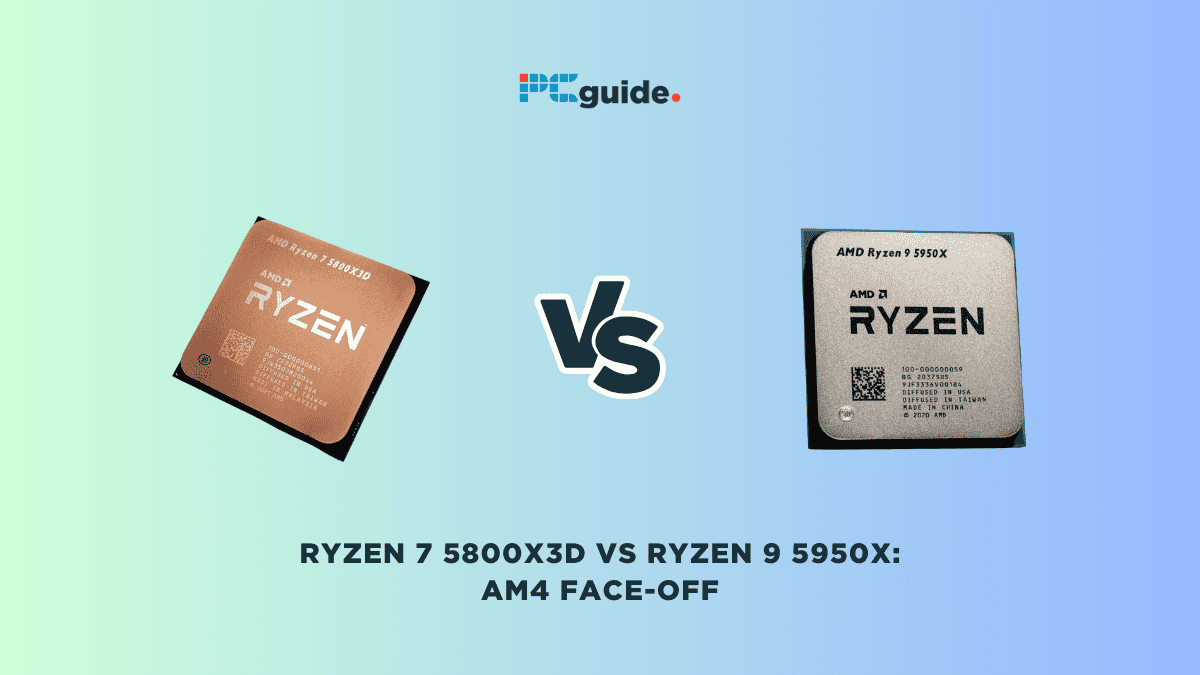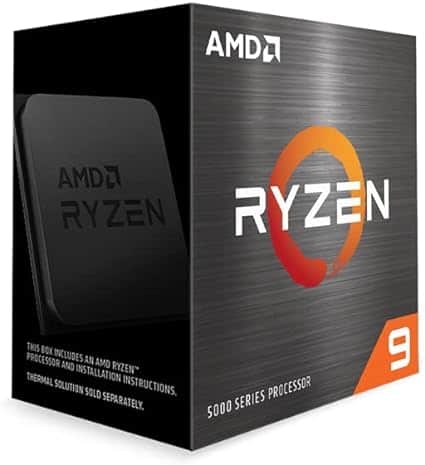Ryzen 7 5800X3D vs Ryzen 9 5950X: AM4 face-off

Table of Contents
The battle of AMD’s powerful processors continues with the Ryzen 7 5800X3D vs. Ryzen 9 5950X, both belonging to the revered AM4 family. Packed with cutting-edge technology and designed to cater to different user needs, these processors stand at the forefront of AMD’s lineup.
In this Ryzen 7 5800X3D vs. Ryzen 9 5950X face-off, we’ll explore the CPUs’ specifications, performance, price, and overall value.
Prime Day is finally here! Find all the biggest tech and PC deals below.
- Sapphire 11348-03-20G Pulse AMD Radeon™ RX 9070 XT Was $779 Now $739
- AMD Ryzen 7 7800X3D 8-Core, 16-Thread Desktop Processor Was $449 Now $341
- ASUS RTX™ 5060 OC Edition Graphics Card Was $379 Now $339
- LG 77-Inch Class OLED evo AI 4K C5 Series Smart TV Was $3,696 Now $2,796
- Intel® Core™ i7-14700K New Gaming Desktop Was $320.99 Now $274
- Lexar 2TB NM1090 w/HeatSink SSD PCIe Gen5x4 NVMe M.2 Was $281.97 Now $214.98
- Apple Watch Series 10 GPS + Cellular 42mm case Smartwatch Was $499.99 Now $379.99
- ASUS ROG Strix G16 (2025) 16" FHD, RTX 5060 gaming laptop Was $1,499.99 Now $1,274.99
- Apple iPad mini (A17 Pro): Apple Intelligence Was $499.99 Now $379.99
*Prices and savings subject to change. Click through to get the current prices.
Ryzen 7 5800X3D vs. Ryzen 9 5950X: Specs comparison
The Ryzen 7 5800X3D and Ryzen 9 5950X, both leveraging AMD’s advanced 7nm architecture, present a fascinating comparison in the realm of high-performance CPUs. These processors, designed for the AM4 socket, showcase AMD’s commitment to delivering cutting-edge technology for diverse computing needs.
Core and thread configuration
The Ryzen 7 5800X3D, with its 8 cores and 16 threads, is tailored for gamers and general users seeking a balance between performance and power efficiency. Its introduction of 3D V-Cache technology marks a significant leap in cache performance, particularly beneficial in gaming and specific computational tasks.
On the other hand, the Ryzen 9 5950X, boasting 16 cores and 32 threads, is a behemoth in multi-threaded performance. Ideal for content creators, 3D artists, and professionals requiring extensive parallel processing capabilities, this processor stands out in demanding environments.
Clock speeds and performance
Both CPUs operate at a base clock of 3.4 GHz. However, the 5800X3D’s boost clock peaks at 4.5 GHz, while the 5950X pushes further to 4.9 GHz. This difference is particularly noticeable in single-core performance, where the 5950X has an edge, enhancing its suitability for tasks that benefit from higher clock speeds.
| Specs | Ryzen 7 5800X3D | Ryzen 9 5950X |
|---|---|---|
| CPU socket | AM4 | AM4 |
| Processor size | 7 nm | 7 nm |
| Transistors | 8,850 million | 8,300 million |
| Cores | 8 | 16 |
| Threads | 16 | 32 |
| P-core base | 3.4 GHz | 3.4 GHz |
| P-core boost | 4.5 GHz | 4.9 GHz |
| L3 cache memory | 96 MB | 64 MB |
| L2 cache memory | 4 MB | 512 KB |
| TDP | 105 Watts | 105 Watts |
| RAM speed | 3200 MHz | 3200 MHz |
| DDR memory support | DDR4 | DDR4 |
| Price | $449 | $799 |
Benchmarks and GPU compatibility
When it comes to benchmarks, both processors demonstrate impressive results, with the 5800X3D excelling in gaming scenarios and the 5950X shining in multi-threaded applications. Their compatibility with a wide range of graphics cards and support for PCIe lanes ensures they can be paired with high-end GPUs for optimal graphics performance.
Power efficiency and thermal design
Despite their power, both CPUs maintain an energy-efficient profile with a 105-watt TDP (Thermal Design Power). This efficiency is crucial for maintaining optimal temperatures and prolonging the lifespan of the hardware components.
Memory and motherboard compatibility
Supporting DDR4 memory with speeds up to 3200 MHz, these processors are compatible with high-speed RAM modules, enhancing overall system performance. Additionally, their AM4 socket compatibility ensures a wide range of motherboard options for users, allowing for flexible and diverse system builds.
The Ryzen 7 5800X3D and Ryzen 9 5950X cater to different user needs but share common ground in their technological prowess. Whether it’s for gaming, content creation, or intensive computational tasks, these processors stand as testaments to AMD Ryzen’s innovation in the CPU market.
Ryzen 7 5800X3D vs. Ryzen 9 5950X: Performance
In the high-stakes competition between the Ryzen 7 5800X3D and Ryzen 9 5950X, understanding their performance nuances is key. Each CPU brings its unique strengths to the table, catering to different user demands.
Core and thread dynamics
The Ryzen 9 5950X, with its impressive array of 16 CPU cores and 32 threads, stands out in multi-threaded applications. This high number of cores and threads translates into exceptional performance in demanding tasks like video editing, 3D rendering, and intensive content creation workflows.
Conversely, the Ryzen 7 5800X3D, featuring 8 cores and 16 threads, is tailored more towards gaming and general productivity. Its core configuration, while lower than the 5950X, is optimized for high-performance gaming, making it a favorite among gamers.
Impact of base frequency and precision boost
Both processors have a significant base frequency, with the 5800X3D and 5950X both starting at a solid 3.4 GHz. The precision boost technology in these CPUs allows them to dynamically adjust frequencies for optimized performance, depending on the workload.
3D V-Cache and iGPU considerations
The introduction of 3D V-Cache in the Ryzen 7 5800X3D is a game-changer, especially in gaming scenarios. This technology significantly improves data access speeds, enhancing gaming performance. While neither CPU comes with an integrated GPU (iGPU), their compatibility with high-end discrete GPUs makes them versatile for various graphical tasks.
Power consumption and efficiency
In terms of power consumption, both CPUs maintain efficiency, balancing high performance with energy use. This aspect is crucial for users who are conscious about their system’s power draw and thermal output.
Comprehensive CPU comparison
A detailed CPU comparison reveals that while the Ryzen 9 5950X leads in raw power and multi-threaded tasks, the Ryzen 7 5800X3D is not far behind, especially in gaming and single-threaded applications. The choice between these two processors ultimately depends on the specific needs and preferences of the user.
The Ryzen 7 5800X3D and Ryzen 9 5950X each excel in their respective domains. Whether it’s for high-end gaming or professional content creation, these processors offer robust solutions, showcasing AMD’s prowess in CPU technology.
Ryzen 7 5800X3D vs. Ryzen 9 5950X: Price and value
While both processors share the same TDP and RAM speed specifications, pricing is crucial. The Ryzen 7 5800X3D is priced at $449, offering a more budget-friendly option for users seeking a balance between performance and cost.
In contrast, the Ryzen 9 5950X, with its superior specifications, commands a higher price tag at $799. The choice between the two depends on individual budget constraints and the computational power required.
Which processor has more physical cores, the Ryzen 7 5800X3D or the Ryzen 9 5950X?
The Ryzen 9 5950X features 16 physical cores compared to the Ryzen 7 5800X3D’s 8 physical cores. This difference in core count contributes to the Ryzen 9 5950X’s overall higher performance, especially in tasks that demand parallel processing.
What is AMD-V?
AMD-V, also known as AMD Virtualization technology, is a hardware virtualization feature that allows multiple operating systems to run on a single physical processor. This technology is particularly useful for businesses and organizations that need to run multiple operating systems for different purposes.
Final verdict
The Ryzen 7 5800X3D is the better contender for gaming needs. With better single-thread performance, the Ryzen 7 5800X3D makes an ideal choice for gaming enthusiasts who want to enjoy high performance at an affordable price.
However, the decision hinges on your needs and budget considerations in the Ryzen 7 5800X3D vs. Ryzen 9 5950X face-off. The 5800X3D provides an attractive balance of performance and affordability, especially with its innovative 3D V-Cache technology.
On the other hand, the Ryzen 9 5950X is a powerhouse tailored for users who demand exceptional computing capabilities for resource-intensive tasks. Consider your usage scenarios, budget constraints, and long-term performance requirements to decide between these impressive AMD processors.


